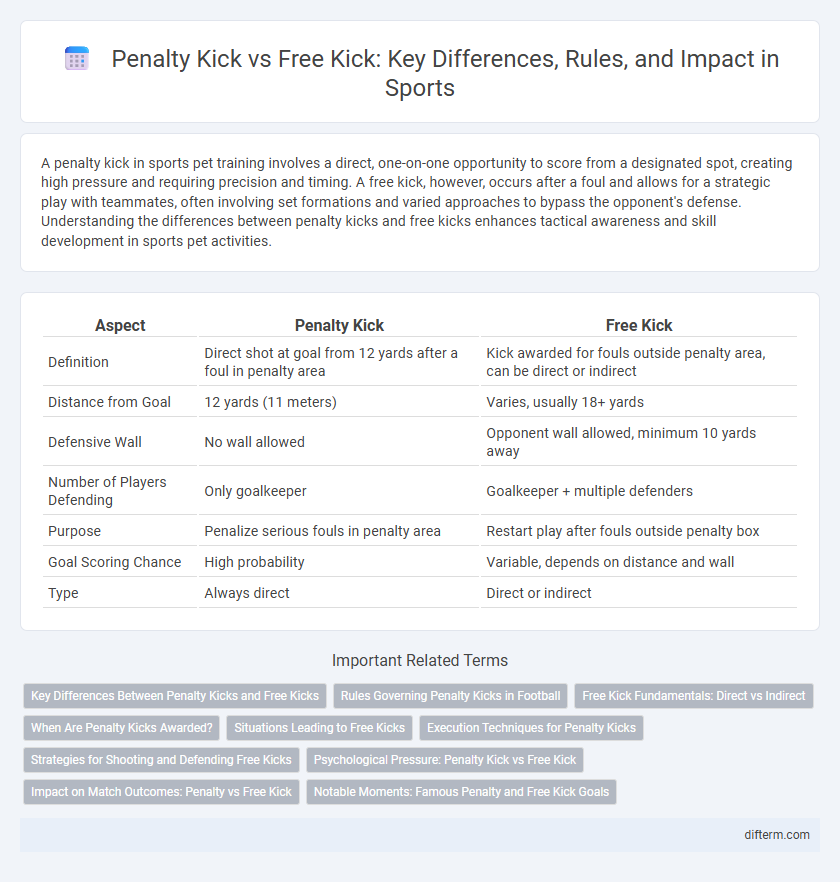A penalty kick in sports pet training involves a direct, one-on-one opportunity to score from a designated spot, creating high pressure and requiring precision and timing. A free kick, however, occurs after a foul and allows for a strategic play with teammates, often involving set formations and varied approaches to bypass the opponent's defense. Understanding the differences between penalty kicks and free kicks enhances tactical awareness and skill development in sports pet activities.
Table of Comparison
| Aspect | Penalty Kick | Free Kick |
|---|---|---|
| Definition | Direct shot at goal from 12 yards after a foul in penalty area | Kick awarded for fouls outside penalty area, can be direct or indirect |
| Distance from Goal | 12 yards (11 meters) | Varies, usually 18+ yards |
| Defensive Wall | No wall allowed | Opponent wall allowed, minimum 10 yards away |
| Number of Players Defending | Only goalkeeper | Goalkeeper + multiple defenders |
| Purpose | Penalize serious fouls in penalty area | Restart play after fouls outside penalty box |
| Goal Scoring Chance | High probability | Variable, depends on distance and wall |
| Type | Always direct | Direct or indirect |
Key Differences Between Penalty Kicks and Free Kicks
Penalty kicks are awarded following a foul committed inside the penalty area and are taken from the penalty spot, allowing only the goalkeeper to defend against the shooter. Free kicks occur after fouls outside the penalty area and can be either direct, allowing a shot on goal, or indirect, requiring another player to touch the ball before a goal can be scored. The positioning, rules, and strategic implications of penalty kicks versus free kicks significantly influence player behavior and game outcomes in football (soccer).
Rules Governing Penalty Kicks in Football
Penalty kicks in football are awarded following specific fouls committed by the defending team inside their own penalty area, with the ball placed on the penalty spot 12 yards from the goal line. All players except the goalkeeper and the kicker must remain outside the penalty area and at least 10 yards from the penalty spot until the kick is taken. The goalkeeper must remain on the goal line between the goalposts and cannot move forward off the line before the ball is struck.
Free Kick Fundamentals: Direct vs Indirect
Free kicks in soccer are categorized into direct and indirect types, each with distinct rules and strategic applications. A direct free kick allows the player to attempt a shot on goal immediately, often awarded for serious fouls, while an indirect free kick requires the ball to touch another player before a goal can be scored, typically given for less severe infractions like offside. Mastery of free kick fundamentals is essential for exploiting set-piece opportunities and increasing scoring chances from these critical game situations.
When Are Penalty Kicks Awarded?
Penalty kicks are awarded when a defending player commits a direct free kick foul inside their own penalty area, such as fouls like tripping, holding, or handball. These infractions must occur within the 18-yard box for a penalty kick to be granted. Unlike free kicks, penalty kicks give the attacking team a one-on-one chance against the goalkeeper from the penalty spot.
Situations Leading to Free Kicks
Free kicks are awarded after fouls such as tripping, handball, or dangerous play within the field, often occurring during defensive or midfield battles. These situations differ from penalty kicks, which are specifically granted for fouls inside the penalty area. The strategic importance of free kicks lies in their potential for direct scoring opportunities or set-piece plays from various distances.
Execution Techniques for Penalty Kicks
Penalty kick execution techniques emphasize precision and power, requiring the player to strike the ball with the instep or side of the foot to control trajectory and speed. Proper approach angle, body positioning, and eye focus on the ball enhance accuracy and reduce goalkeeper prediction effectiveness. Consistent practice of techniques such as stutter steps, planting foot alignment, and follow-through improves success rates in high-pressure situations.
Strategies for Shooting and Defending Free Kicks
Effective strategies for shooting free kicks involve precise ball placement, varying shot techniques like curling or power strikes, and exploiting wall gaps or goalkeeper positioning. Defenders focus on organizing the wall to block the most probable target areas while the goalkeeper anticipates shot direction using cues from the kicker's approach and body language. Coordinated communication between defenders and goalkeepers is crucial for minimizing scoring opportunities from free kicks.
Psychological Pressure: Penalty Kick vs Free Kick
Penalty kicks impose intense psychological pressure on both the kicker and goalkeeper due to the one-on-one scenario and high expectations for success, often determining the match outcome. Free kicks involve less direct pressure as the kicker faces a defensive wall and the goalkeeper, allowing more time for preparation and strategy. The mental challenge in penalty kicks stems from the immediate spotlight and decisive nature, whereas free kicks allow for complex tactics and psychological gamesmanship.
Impact on Match Outcomes: Penalty vs Free Kick
Penalty kicks have a higher success rate, significantly influencing match outcomes by providing direct scoring opportunities under pressure. Free kicks offer strategic advantages through set-piece variations, often leading to key goals or creating scoring chances from indirect plays. The decisive impact of penalty kicks on match results contrasts with free kicks, which contribute more to tactical build-up and positional advantage.
Notable Moments: Famous Penalty and Free Kick Goals
Diego Maradona's iconic penalty against England in the 1986 World Cup and David Beckham's memorable free kick goal for England in Euro 2004 highlight the dramatic impact of set-piece situations in football history. Roberto Carlos' thunderous free kick against France in 1997 remains one of the most celebrated moments, showcasing exceptional technique and power. Cristiano Ronaldo's numerous decisive penalty kicks for Portugal in international tournaments emphasize the pressure and skill involved in these critical goal-scoring opportunities.
penalty kick vs free kick Infographic

 difterm.com
difterm.com